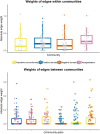The network structure of schizotypy in the general population
- PMID: 31646383
- PMCID: PMC8119252
- DOI: 10.1007/s00406-019-01078-x
The network structure of schizotypy in the general population
Abstract
Schizotypal personality traits show similarity with schizophrenia at various levels of analysis. It is generally agreed that schizotypal personality is multidimensional; however, it is still debated whether impulsive nonconformity should be incorporated into theories and measurement of schizotypy. In addition, relatively little is known about the network structure of the four-dimensional model of schizotypal personality. To estimate the network structure of schizotypy, we used data from participants recruited from the community (N = 11,807) who completed the short version of the Oxford-Liverpool Inventory of Feelings and Experiences, a widespread self-report instrument that assesses the positive, negative, disorganised and impulsive domains of schizotypy. We performed community detection, then examined differences between communities in terms of centralities and compared the strength of edges within and between communities. We found communities that almost perfectly corresponded to the a priori-defined subscales (93% overlap, normalised mutual information = 0.74). Items in the disorganisation community had higher closeness centrality relative to items in the other communities (Cliff's Δs ranged from 0.55 to 0.83) and weights of edges within the disorganisation community were stronger as compared to the negative schizotypy and impulsive nonconformity communities (Cliff's Δs = 0.33). Our findings imply that the inclusion of impulsive nonconformity items does not dilute the classical three-factor structure of positive, negative and disorganised schizotypy. The high closeness centrality of disorganisation concurs with theories positing that cognitive slippage and associative loosening are core features of the schizophrenic phenotype.
Keywords: Factor structure; Network analysis; Personality; Schizophrenia; Schizotypy.
Conflict of interest statement
The authors declare that they have no conflict of interest.
Figures



References
-
- Meehl PE. Schizotaxia, schizotypy, schizophrenia. Am Psychol. 1962;17:827–838. doi: 10.1037/h0041029. - DOI
MeSH terms
Grants and funding
LinkOut - more resources
Full Text Sources
Medical

